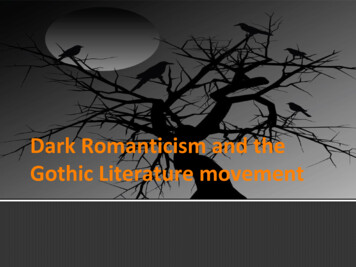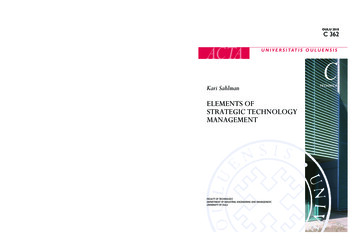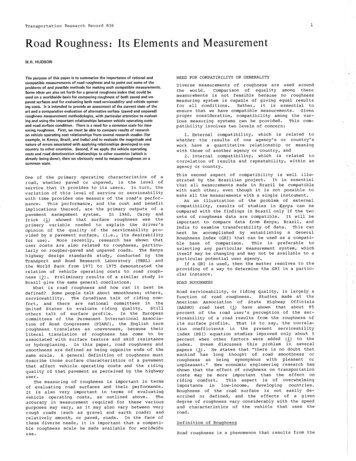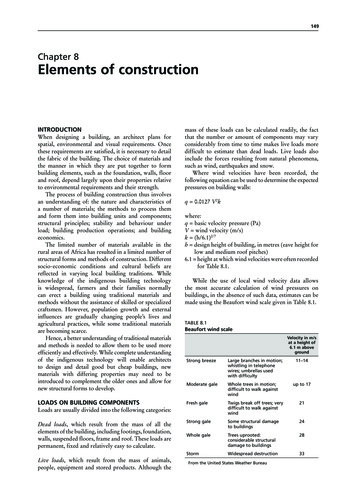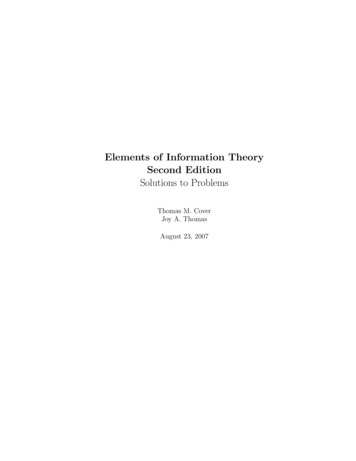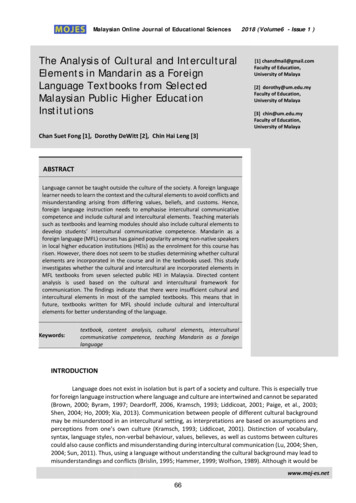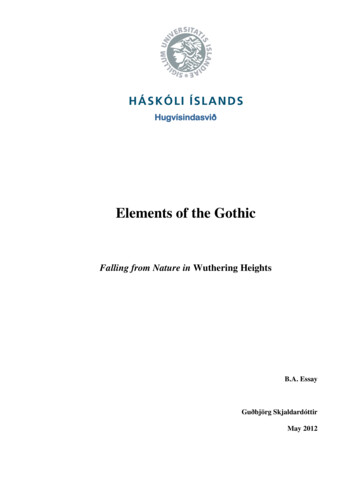
Transcription
HugvísindasviðElements of the GothicFalling from Nature in Wuthering HeightsB.A. EssayGuðbjörg SkjaldardóttirMay 2012
University of IcelandSchool of HumanitiesDepartment of EnglishElements of the GothicFalling from Nature in Wuthering HeightsB.A. EssayGuðbjörg SkjaldardóttirKt.: 031273-4209Supervisor: Anna Heiða PálsdóttirMay 2012
AbstractThe purpose of this thesis is to explore the elements of the Gothic and the way thesewere employed to create one of the most controversial stories of the English language,Emily Brontë’s Wuthering Heights (1857). Taking a brief look at the origins of theGothic genre and exploring the notion of the sublime as being a central factor for theGothic endeavour, the thesis explores some of the elements by which a story can becategorized as a Gothic narrative. While the purpose of Gothic stories has frequentlybeen to shock and sensitize the reader, the form of the Gothic has also been the meansthrough which authors have addressed their concerns regarding all factors of life, bethey cultural or individual.At the time of Emily Brontë’s publication of Wuthering Heights, societal changesin Britain were tremendous: with the industrial revolution, the population wasincreasingly abandoning the rural life of agriculture for the urban life of the cities. Asregards Emily Brontë’s character, it is clear that she was one of few who held natureand what she believed to be man’s essential nature in the highest regard, caring little forthe so-called “society” of man. As a fierce naturalist who found her liberty on theruggedness of her childhood moors, Emily Brontë wrote her story of the opposingforces of nature versus culture portrayed in the houses of Wuthering Heights andThrushcross Grange.While the thesis elaborates on the elements of the Gothic that characterizeWuthering Heights as a Gothic story, it argues that through a more careful analysis,Emily Brontë’s hidden agenda is revealed. It thus becomes evident that through thegloom of Gothic fiction, the darkness of Brontë’s vision stems from the conviction thatin a society that will see nature tamed, man’s essential nature would inevitably be lost.1
Table of Contents1. Introduction . 32. Origins of the Gothic and the Sublime . 53. Elements of the Gothic and Wuthering Heights . 73.1 The sublime Landscape . 83.2 The Elements . 83.3 The Supernatural Effect . 93.4 The Antiquated Castle . 103.5 The Villain-protagonist . 114. Emily Brontë: Life and Nature. 154.1 The Nature of the “Civilized” . 164.2 Nature’s corruption by civilization . 184.3 Nature’s last stand . 20Conclusion . 23Works cited . 242
1. IntroductionCreating a literary form is something scarcely thought possible to trace back to a singlehuman being, but that however, remains the case with the beginnings of what laterbecame known as the Gothic genre. Its origins have been dated back to the year 1765,with author Horace Walpole’s reissue of The Castle of Otranto, in which he subtitledhis work: “A Gothic Story” (Hogle I). The genre was an attempt to blend ancientromance with the modern, to create stories in which the sublime “terror” would be the“author’s principal engine” (Hume 282). Through Walpole’s endeavour, the standardwas set for all other Gothic novels to follow.Walpole’s idea of sublimity as an emotion, ultimately achieved via the feeling ofterror, was a concept promoted by philosopher Edmund Burke some eight years prior toWalpole’s Castle of Otranto. According to Burke’s theory the feeling of terror, inducedby the idea of a possible pending danger, is in all cases the source for achieving thefeeling of sublimity. Adopted by the authors of Gothic literature, the idea of the sublimebecame a central factor for the Gothic endeavour, around which all the action is built.Moreover, with the Gothic form being adjustable to most genres, it gradually developedinto the principal mode for authors who would use the terrible sublime to address anddisguise their concerns regarding the widest aspects of the social and culturalponderings of their time.While a hundred and sixty five years have passed since the publication of EmilyBrontë’s Wuthering Heights, it remains to this day a source of endless fascination forscholars and laymen alike. By many considered one of the greatest love stories written,Brontë’s only novel published, under the pseudonym Ellis Bell, was highlycontroversial due to its extremely raw depiction of cruelty, hate, and vengeance.Throughout the years the narrative has been proposed as a candidate for just about everyliterary theory the English language has to offer, including Romanticism and, whatseems more plausible, Gothicism. The following analysis will thus draw on theelements of the Gothic, and view the way in which they have been employed to createthe sublime atmosphere surrounding the narrative of Wuthering Heights.Although there can be no doubt that the narrative, indeed, is a Gothic story, acharacter analysis of Emily Brontë demands for a closer reading of the narrative toexplore the possible agenda hidden within. The accounts available regarding Emily’slife, and outlook, provide for a person who was highly preoccupied with the relativelyuntouched parts of nature. Much like her characters Heathcliff and Catherine of3
Wuthering Heights she would spend much of her time rambling for liberty on themoors of her childhood surroundings (Brontë, Charlotte 311).Living in the post industrial-revolution England, in which people wereincreasingly abandoning agricultural settings for urbanization, Brontë’s central concernwas that people were becoming divorced from the nature she held so dear (Giddens157). Moreover, in a society that increasingly viewed nature as an obstacle in need oftaming to Brontë, it was not nature that posed the problem but the modern industrialsociety (Giddens 157). Believing that the wild nature should remain protected ratherthan domesticated, she thus presents the opposing forces of Thrushcross Grange,representing the “civilized” of society and Wuthering Heights, in which the essentialnature of man still resides in the body of Heathcliff. In her allegory of man’s inevitablefall from nature in a society that aims to tame it, Brontë uses the sublimity of the Gothicnarrative to pose her belief that the anthropocentric view of the “civilized” man will bethe destruction of all that is nature.4
2. Origins of the Gothic and the SublimeThe history of the Gothic tradition in literature can be traced back to the latter part ofthe seventeenth century, with author Horace Walpole being the first to coin the term inhis preface to the second edition of The Castle of Otranto (Hogle I). According toRobert D. Hume, Walpole claimed in his account that, “terror” was “the author’sprincipal engine,” serving as a means to involve and disturb the reader (282).Claiming the genre constituted of a blend of the ancient romance with the modern,Walpole’s new form was favoured only be few until in the 1790s when it becametremendously popular in the British Isles, spreading from there to Europe and the NewUnited States. The genre further continued to flourish throughout the romantic period;its characteristics were adopted into various modes of literature, including the Victoriannovel, such as Emily Brontë’s Wuthering Heights (Hogle I). From the eighteenthcentury on, the Gothic genre has, to a more or lesser degree, sustained its popularityamong the readers of fiction, with the reason undoubtedly being that its concepts can beadjusted to most kinds of literature, regardless of genre. According to Jerrold Hogle, thelongevity and power of the Gothic novel is due to the way in which it addresses anddisguises a number of the primal desires, ponderings and sources of anxiety, belongingto man, “from the most internal and mental to the widely social and cultural” aspects ofexistence (4).The idea of sublimity, adopted by the authors of Gothic literature as an emotionultimately achieved via the feeling of terror was a redefinition, made by Edmund Burkeof a concept previously used in relation to the beautiful (Morris 299). According toDavid B. Morris, Burke’s work consolidated the different materials of earlier accountswithin a single unified system, in which he irreconcilably split the sublime from thebeautiful. In Burke’s view, all aspects of sublimity are governed by a singlecomprehensive power, explaining his theory: “Terror is in all cases whatsoever, eithermore openly or latently the ruling principle of the sublime” (Morris 300).In The genesis of “Gothic” fiction, E.J. Clery states that Burke, in his work,“begins by outlining the problem of indifference, a state of mental lethargy broughtabout by a steady diet of the familiar,” suggesting that in order to achieve sublimity, thefeeling of “pleasurable pain” is much more sufficient than the merely positive pleasureassociated with beauty alone (Clery 28). Burke suggests:5
Whatever is fitted in any sort to excite the ideas of pain, and danger, that isto say, whatever is in any sort terrible, or is conversant about terribleobjects, or operates in a manner analogous to terror, is a source of thesublime; that is, it is productive of the strongest emotion which the mind iscapable of feeling. (Burke 1759)Moreover, Clery quotes Burke’s statement that “the sublime being anapprehension of danger in nature or art, without the immediate risk ofdestruction ” and that the imagination must be “shaken and worked to a properdegree” by images and ideas of the terrible sublime (Clery 28).Continually, Burke’s theory has been linked to the Gothic explorations ofterror, where author’s would create the desired atmosphere in a space far removedfrom the reader’s sphere of experience, thus minimizing the risk of “destruction”for the reader himself. In this sense, the notion of Burke’s sublime, has beenclaimed to be the central factor for the terror-driven Gothic experience.6
3. Elements of the Gothic and Wuthering HeightsWhile the sublime is considered the most prominent and the most enduringcharacteristic of the Gothic endeavour there are certain general features applied to createthe atmosphere necessary, and by which a narration might be identified as a Gothicstory (Hume 282). According to Hume the early Gothic authors’ emphasis was towardan inward move from the neoclassical realistic outlook in which the literature wouldgenerally focus on the exterior actions of life, to drawing the reader’s attention to theinternal psychological processes and reactions of men (288). Authors’ main aim wasthus to involve the reader in a new way by creating scenes which would arouse hisimagination and stimulate the senses (Hume 284). One of the major components in theinvolvement of the reader was to remove him from his daily life, from where everydaystandards and moral values would not intervene with the probability of events in thestory (Hume 286).Consequently, the authors of Gothic fiction would frequently present a moralnorm in their stories, often in the form of an outsider such as Mr. Lockwood inWuthering Heights, providing the reader with a standard recognized as close to hiseveryday outlook (Hume 286). The reader’s views on the action as well as on theGothic-villain, from whom most of the action derives, would then coincide with theoutsiders; hence, Lockwood’s experience would become their own. The absence of thereader’s everyday beliefs would, furthermore, prove necessary to create the probabilityof the ever popular supernatural occurrences. While such events occurring within thecomfort of the reader’s home might be improbable, they would serve as a valid enoughdevice for the narrative to remove him from his realistic everyday outlook (Hume 284).In addition to the abovementioned features the Gothic atmosphere is frequentlytransmitted through the setting of an “antiquated or seemingly antiquated space,” suchas castles or mansions in faraway countries (Hogle 2), and through “raging storms, darknights, tyranny, incarceration, and torture” (Morris 301).When considering the abovementioned criteria for a narrative to be categorized asbeing a Gothic, there can be no doubt that Emily Brontë’s story of the self-containedworld of Wuthering Heights, indeed, is a Gothic story. In her narrative, the reader isdrawn into the dark, hostile, and isolated world of the Yorkshire moors by Mr.Lockwood, through whom the sublime atmosphere of the Gothic is transmitted.Through his eyes the reader will witness the repugnance and brutality of the inhabitantsof Wuthering Heights and feel the terror in his encounter with the supernatural.7
Additionally, the reader will share Lockwood’s curiosity in wanting to know the causeof how things came to be in their prese
feeling of sublimity. Adopted by the authors of Gothic literature, the idea of the sublime became a central factor for the Gothic endeavour, around which all the action is built. Moreover, with the Gothic form being adjustable to most genres, it gradually developed into the principal mode for authors who would use the terrible sublime to address andAuthor: Guðbjörg SkjaldardóttirPublish Year: 2012

